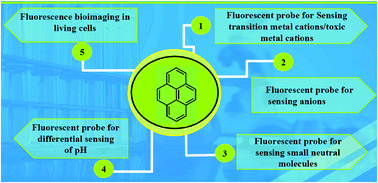Pyrene based materials as fluorescent probes in chemical and biological fields
Abstract
Molecules that experience a change in their fluorescence emission due to the effect of fluorescence enhancement upon binding events, like chemical reactions or a change in their immediate environment, are regarded as fluorescent probes, because of their high selectivity and advantages in the fields of chemical, biological, and medical chemistry. Fluorescent probes have become a predominant aid for the detection of target materials like metal cations, anions, and neutral molecules in the bio-imaging field and also have great importance in the detection of reactive oxygen species (ROS) and reactive carbonyl species (RCS) in living cells, air, soil, and food. Pyrene and its derivatives are important polycyclic aromatic hydrocarbons that act as fluorophores and are widely used as a fluorescent probe on account of their strong emission of fluorescence in live cells, very low cytotoxicity, high fluorescence quantum yield, easy modification, and outstanding cell permeability. In this review, the methods of design and synthesis of versatile pyrene fluorophores for the selective and sensitive quantification of their activity will inspire further reaction development in this interesting area.

- This article is part of the themed collection: 2021 Focus and Perspective articles


 Please wait while we load your content...
Please wait while we load your content...